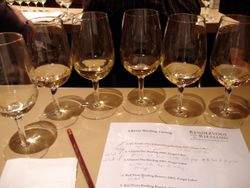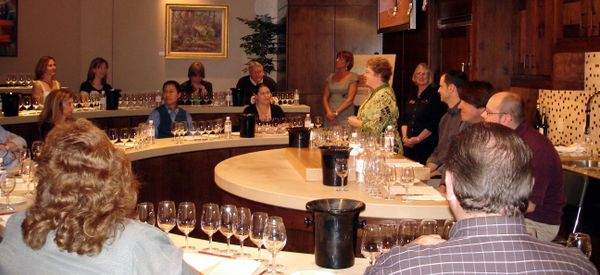By Evan Dawson, Finger Lakes Correspondent
Photos by Jason Feulner, Finger Lakes Correspondent
Something special happened Friday night at the New York Wine Wine & Culinary Center, and the effects are likely to echo for a long time.
Every wine lover has a special bottle or two that stir vivid memories. Simply gazing at the label is enough to transport the owner to the time and place when the bottle was consumed. For me, there is one bottle of wine so special that I can picture the room in which I drank it when I see the label. When I hear the song that was playing at the time (David Grey's "Say Hello Wave Goodbye") I can literally taste the wine once more.
In the Finger Lakes, it has long been a challenge to elevate local wines to this unique place for the wider market. After all, most wines are sold not long after bottling, and most producers urge consumers to drink the wines when they are young. Many special wines can be laid down for a decade or more, and such patience doesn't simply preserve quality, it enhances it.
On Friday night, a trend gained momentum: Finger Lakes rieslings are showing gorgeously as they age, and the consuming public is finally gaining a chance to experience that.
 I was honored to be asked to join a panel presenting Finger Lakes Rieslings at various stages of development. With an audience of about 30 — an audience that was uniformly geeked out about local wines — we tasted through eight rieslings. Here was the lineup:
I was honored to be asked to join a panel presenting Finger Lakes Rieslings at various stages of development. With an audience of about 30 — an audience that was uniformly geeked out about local wines — we tasted through eight rieslings. Here was the lineup:
- Dr. Frank's Vinifera Wine Cellars 1997 Dry Riesling
- Glenora Wine Cellars 2000 Dry Riesling
- Glenora Wine Cellars 2001 Dry Riesling
- Red Newt Cellars 2002 Dry Riesling
- Red Newt Cellars 2003 Dry Riesling
- Hermann J. Wiemer 2003 Dry Riesling Reserve
- Ravines Wine Cellars 2004 Dry Riesling
- Fox Run Vineyards 2004 Riesling
Anyone who doubts the lifespan of Finger Lakes rieslings ought to have watched the audience taste the 1997 Dr. Frank. It was like inviting a group of people to a book reading and having them read Hemingway for the first time.
Unfortunately, I found the Glenora offerings to be a mess — slightly off-tasting, oniony and not varietally typical - though many in the audience enjoyed them as well. But it was the Red Newt 2002 that reached up out of the glass and delivered a knockout blow to me.
As we learned last week with a veritcal of older Wiemer rieslings, 1999 and 2002 Finger Lakes rieslings are showing historically special characteristics. This wine had more layers than a kindergartner waiting for the bus on a winter day in Fargo. Even better, winemaker Dave Whiting says there are at least 10 cases still in existence and some is for sale in the Red Newt Bistro.
Comparing the pair of 2003s and 2004s was a blast, as each wine was made with fruit from different sources and made by winemakers with different techniques. I am deeply intrigued to see where the Ravines style of Dry Riesling goes as it ages, as it marks the driest of Finger Lakes riesling (0.3% RS).
The panel convened by the NYWCC's Shannon Brock, did a fabulous job, and I was simply trying not to get in the way. Wine educator Lorraine Hems is a natural, and Ravines' winemaker Morten Hallgren addressed a variety of thoughtful questions.
As a bonus, Red Newt's Whiting was in the audience to offer insight, as was Fox Run's assistant winemaker Tricia Renshaw, and a longtime member of Dr. Frank's staff.
Nascent wine regions need decades to discover the true arc of aging for their best wines. Thanks to events like this one, we're seeing the Finger Lakes' best rieslings as they evolve into something that is occasionally extraordinary — perhaps so extraordinary that you'll taste it and freeze the moment in your mind, recalling the music that was playing, the art on the walls, the company with whom you enjoyed the bottle. And perhaps in the future you will hear a song and, somehow, the music will taste like a Finger Lakes Riesling, evolving to tell yet another story when you open it once more.

